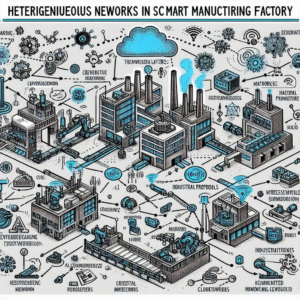Introduction
The advancement of Industrial IoT (IIoT) has revolutionized modern smart manufacturing, enabling real-time communication and automation across production facilities. A key enabler of this transformation is heterogeneous networks, which integrate multiple wired and wireless communication technologies. These networks connect diverse industrial IoT devices, ensuring seamless data exchange and process optimization.
However, managing heterogeneous networks presents challenges such as differing quality of service (QoS) requirements, complex network topologies, and dynamic reconfiguration needs. This article explores the classification of heterogeneous networks, key technologies, and AI-enabled optimization techniques to enhance IIoT connectivity in smart manufacturing environments.
Challenges in Heterogeneous Networks for Industrial IoT
Diverse QoS Requirements
IIoT applications have varying latency, bandwidth, and security needs. For example, real-time control systems require low latency (≤10ms), while data-heavy applications such as augmented reality (AR) demand high bandwidth (>1,600 Mbps). Balancing these requirements is crucial for network efficiency.
Integration of Wired and Wireless Networks
Smart factories rely on a mix of wired networks (Ethernet, fieldbus systems) and wireless networks (Wi-Fi, Zigbee, LPWAN, and 5G). While wired networks offer high reliability, wireless networks provide flexibility and scalability. Effective integration is necessary to prevent transmission issues and delays.
Complex Network Topologies
With numerous connected industrial IoT devices—ranging from production machines to logistics equipment—networks become complex. This necessitates advanced network management strategies to ensure smooth data flow and minimize disruptions.
Dynamic Reconfiguration Needs
Manufacturing environments frequently evolve, requiring networks to adapt to new devices and changing operational demands. Automated network reconfiguration enhances adaptability and efficiency.
Classification and Key Technologies of Industrial IoT Networks
Heterogeneous networks in smart factories can be categorized based on their communication technologies:
Industrial Wired Networks
These networks ensure high-speed, low-latency communication and include:
– Fieldbus Systems (PROFIBUS, Modbus, CC-Link) – Widely used but limited in bandwidth.
– Real-Time Ethernet (RTE) (EtherCAT, PROFINET) – Provides deterministic communication and supports time-sensitive operations.
Industrial Wireless Networks (IWNs)
Wireless networks enable greater flexibility in IIoT connectivity:
1. Wi-Fi – Common for factory automation, though it faces interference challenges.
2. Zigbee & LPWAN – Energy-efficient options for low-data-rate sensor networks.
3. 5G Networks – Enables ultra-reliable low-latency communication (URLLC) for industrial automation.
Power Line Communication (PLC)
PLC allows data transmission over power lines, offering a cost-effective alternative where network cabling is impractical. However, signal degradation remains a concern.
Edge Computing and Software-Defined Networking (SDN)
– Edge Computing reduces latency by processing data near the source.
– SDN separates network control from the data plane, enabling centralized network management.
SDN and Edge Computing Framework for Industrial IoT
An SDN- and edge computing-based framework enhances heterogeneous network performance in smart factories. This architecture consists of:
East-West Flow Plane
Facilitates real-time communication among industrial IoT devices, supporting machine-to-machine (M2M) interactions.
North-South Flow Plane
Handles data exchange between on-premise factory systems and cloud-based analytics platforms.
Computing Plane
Integrates edge computing for low-latency data processing, reducing cloud dependency and enhancing responsiveness.
With SDN, network resources are dynamically allocated based on real-time requirements, optimizing IIoT applications and improving overall factory efficiency.
AI-Enabled QoS Optimization for Industrial IoT Networks
Artificial Intelligence (AI) improves QoS optimization in heterogeneous networks by enabling:
Low-Latency Mobile Handover
AI-driven ant colony optimization algorithms streamline mobile device handovers in wireless networks, reducing connection drops.
Adaptive Data Transmission Strategies
AI prioritizes time-sensitive data packets, ensuring that critical factory processes operate without delays.
Load Balancing and Routing Optimization
- Deep Reinforcement Learning enhances network load balancing, preventing congestion.
- AI-based routing algorithms dynamically adjust paths to optimize data transfer speeds.
Blockchain for Security and Privacy
Blockchain technology ensures secure, tamper-proof data transmission, protecting sensitive industrial IoT information from cyber threats.
Validation of QoS Optimization Methods in Smart Factories
To verify the efficiency of QoS optimization techniques, real-world testing is essential.
Edge Computing Proactive Caching
By storing frequently accessed data at the network edge, factories can reduce latency and enhance system responsiveness.
AI-Optimized Mobile Handover
Testing ant colony-based mobile handover strategies ensures minimal latency and seamless connectivity.
Deep Learning-Based Routing and Load Balancing
Simulations evaluating AI-driven network routing provide insights into improved data throughput and reduced congestion.
Conclusion: Smart Manufacturing with Heterogeneous Networks
Industrial IoT-powered heterogeneous networks play a vital role in enabling smart manufacturing. By integrating wired and wireless networks, SDN, edge computing, and AI-driven QoS optimization, factories can achieve:
– Seamless connectivity between diverse IIoT devices
– Lower latency and higher reliability in industrial applications
– Enhanced security and optimized network performance
As manufacturing continues to embrace digital transformation, refining heterogeneous network frameworks will be key to unlocking next-generation smart factory capabilities. By adopting advanced network optimization techniques, industries can enhance efficiency, security, and scalability in their IIoT ecosystems.
Do you like to read more educational content? Read our blogs at Cloudastra Technologies or contact us for business enquiry at Cloudastra Contact Us.
